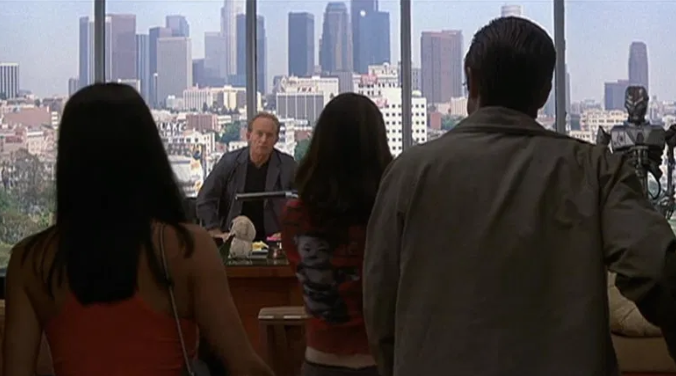With Kevin Williamson’s indelible imprint on Scream and Scream 2, there was no denying that the script for the third installment would be doomed without his signature style (rife as it is with an encyclopedic knowledge of pop culture and vocabulary words teens had never been formerly associated with using). Particularly since then newly assigned writer Ehren Kruger had not yet really established himself with an ideal track record for the horror genre (that would come after Scream 3 with the likes of The Ring and The Skeleton Key–which, yes, Get Out definitely culled elements from). In fact, despite Williamson creating a number of story notes for the script, Kruger disregarded them (maybe that’s part of why Williamson felt obliged to resuscitate the franchise one last time for 2011’s Scream 4). But then, perhaps if he hadn’t, we wouldn’t have the overt allusions to Harvey Weinstein’s predilection for sexual predatoriness at the core of the movie’s plot twist.
What’s more, Scream 3 would be the first in the franchise to collaborate with The Weinstein Company as its production company, with the first wielding Woods Entertainment (with distribution by Dimension Films) and the second Konrad Pictures and Craven-Maddalena Films. Thus, it seems slightly more than coincidental that John Milton (Lance Henriksen) should appear as a character in the already meta film within a film concept of Scream 3. Centered around the making of Stab 3 (just as Scream 2 featured Stab as the foil for Scream), Milton is a relic of a producer who got his start in the business in the 70s, veering toward low-budget horror movies as his bread and butter. Weinstein, too, was willing to dabble in trashy, subpar productions if it meant a leg up on the road to ultimate film power (therefore sexual predator glory)–including producing concerts under the moniker Harvey and Corky Productions while attending the University at Buffalo.
At least Milton had the faux excuse for his behavior of: “It was in the ’70s. Everything was different. I was well-known for my parties. Rina knew what they were.” Rina, in this case, being Rina Reynolds, the stage name of Maureen Prescott (Lynn McRee) during her little known stint spent in Hollywood trying to become an actress. Considering Sidney (Neve Campbell) is all too aware of, let’s say, mama’s penchant for being a “rollin’ stone,” she’s not that surprised upon learning that “Rina” made quite a name for herself while in town. Though it is Gale Weathers (Courteney Cox, whose Scream 3 hairstyle has been the subject of many memes) who first intimidates Milton for the information, storming his office with the threat, “How would you like to see [this information] dug up on national TV? Why don’t you tell me what happened?” Milton starts talking real quickly then, letting his lips flap with far more ease than any of Harvey Weinstein’s victims, explaining, “It was for girls like her to meet men. Men who could get them parts… if they made the right impression. Nothing happened to her that she didn’t invite in one way or another–no matter what she said afterwards.”
Well-aware of what he’s implying but still highly disgusted by the implication, Gale–Gale “No Mercy” Weathers, of all people–asks, “Are you saying she…?” The unfinished ellipsis letting the viewer’s imagination do the guessing with regard to conjuring the worst possible image. Milton asserts, “I’m saying things got out of hand. Maybe they did take advantage of her. You know, maybe the sad truth is: this is not the city for innocents. No charges were brought. And the bottom line is, Rina Reynolds wouldn’t play by the rules. You wanna get ahead in Hollywood? You gotta play the game, or go home.” This skewed logic, to be sure, is why Weinstein got away with his horrific “antics” for so many decades, with all Hollywood aspirants assuming it was the only and requisite way to get ahead (by giving so much more than just head). What’s worse, those already firmly ensconced in the industry either turning a blind eye to the repugnant behavior or, possibly worse, capitalizing on it in some way for themselves (as the men that did at Milton’s illustrious “screening” parties). For if you can’t tear the monster down, you might as well build him up even further by benefitting from some of the “perks” he has to offer for your silence.
The vilification of the actress–the woman–being responsible for baiting the man in power without being completely willing to “do what it takes” is another alarming element of John Milton’s explanation for the abuse that forever tainted Maureen even after she fled from Hollywood. And “what it took,” apparently, was getting gang raped by the group of “power players” at Milton’s party. When Maureen tried to tell of what happened to her, she was summarily blacklisted. So no, one wouldn’t say that “playing the game” really helped her career. And, in fact, Weinstein seemed to be latently pulling the puppet strings on this aspect of the narrative as a means to show what can happen to women who try to blab.
To boot, Weinstein’s known diabolical pleasure from getting away with his Caligulan delights in plain sight is arguably most primely (and sickly) revealed in Scream 3, which he possibly chose to let slide in this particular film for how rarely viewed it is in comparison to its two predecessors. Yet it is for this reason that Scream 3 might just be the creepiest out of all four installments.






















